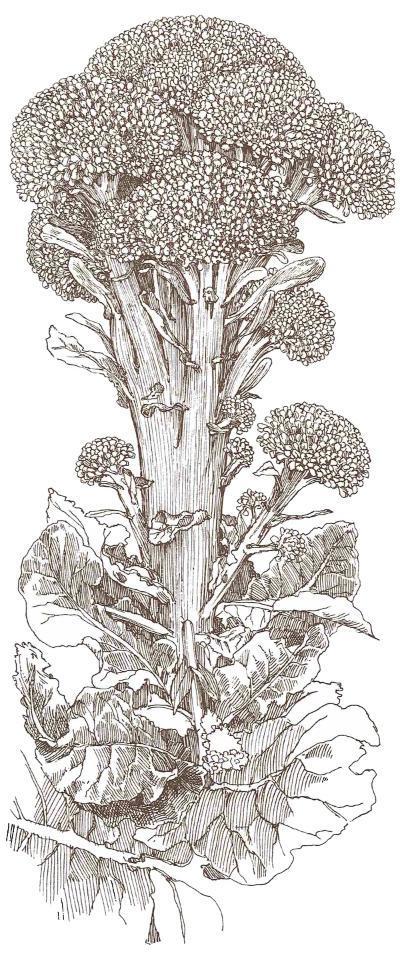 Gardeners often group broccoli, Brussels sprouts, cabbage, cauliflower and kohlrabi together as "cole crops". Cole is the German word for cabbage, hence the term "cole slaw". Cole crops are hardy and grow best in cool weather. An easy way to remember this is to think how much "cole" sounds like "cold" or "cool".
Gardeners often group broccoli, Brussels sprouts, cabbage, cauliflower and kohlrabi together as "cole crops". Cole is the German word for cabbage, hence the term "cole slaw". Cole crops are hardy and grow best in cool weather. An easy way to remember this is to think how much "cole" sounds like "cold" or "cool".
Cole crop seed is slightly more tender than the mature plant. In order to sprout, it must be planted in rich, moist soil with the air temperature about 60° F and the soil temperature at least 45° F. Germination occurs four to eight days after planting seeds.
Once a seed sprouts, it sends down the start of its taproot while the stem and first leaves develop. These first leaves are called seed leaves. True leaves appear next and the plant is on its way toward fulfilling its natural goal: to produce flower buds that will eventually open and give way to a seed stalk.
Cabbage and Brussels sprouts actually surround a seed case with their tightly folded leaves, forming a head. Broccoli and cauliflower heads, or "curds", are tight bunches of the buds themselves.
Once the heads have formed, they gradually loosen (unless you pick them, of course) to make room for the seed stalk to develop. This loosening action is triggered under certain temperature, daylight and growing conditions, causing the plant to bolt, or go to seed.
Broccoli - Sprouts with Clout!When broccoli first came to this country from Italy, it was considered exotic. Now, it's as much a part of our gardens and kitchens as peas or carrots.
The bluish green mature heads of broccoli can be harvested from early summer to late fall, depending on your climate and growing conditions. Once the first large head is harvested, most broccoli varieties produce smaller side, or lateral, shoots that extend the harvest for weeks.
In the North, plant broccoli in the early spring and again in midsummer for a fall harvest. The only time the plants won't produce heads is during the hottest weeks of summer. Your fall crop, however, will keep bearing shoots after the rest of your garden is spent. In the South, plant in late winter for an early summer harvest or early fall for winter harvesting. In warmer areas, you might want to try overwintering broccoli varieties.
There are several dependable, early varieties of broccoli, among them:
Even though Brussels sprouts have been a mealtime tradition for hundreds of years, many people dislike them. You may change your mind, however, if you grow your own. The difference between frozen supermarket sprouts and your own, fresh from the garden, is unbelievable.
Growing Brussels sprouts is almost as much fun as eating them. They start out looking just like cabbage or broccoli, but as they grow, the stems become tall and thick and sprouts pop out above each large leaf along the main stems. They look like miniature palm trees. You add to this look by breaking off the lower leaves once the harvest begins. The stems can end up two to three feet high, loaded with sprouts.
This vegetable originated in Brussels, Belgium, and is still extremely popular in Europe. As more Americans try them, Brussels sprouts are becoming better known and enjoyed in this country, too.
'Long Island Improved' is the most popular variety of Brussels sprouts. 'Jade Cross' is desirable for its disease resistance and 'Rubine Red' for its red foliage and sprouts. These varieties mature 80 to 90 days after transplanting, and they grow best as a fall and early winter crop. The sprouts not only withstand frosts, their flavor improves as the weather gets cooler.
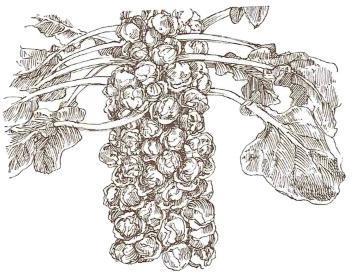
Cabbages of all kinds are a snap to grow and are one of the few salad vegetables you can have available from your garden well into winter. Raw cabbage is said to possess great healing power, and at one time it was prized by the Egyptians.
Cabbages can be either early, for spring planting, midseason, for planting anytime, or late for a fall crop. One thing to remember is that the late varieties need a longer growing season than the others, so you may end up planting your fall harvest earlier than a midseason variety. Check the seed packet for the days to maturity. Count back from the time you'd like to begin harvesting, and you'll have a handy planting and harvesting timetable.
Because cabbages are biennial plants, you don't have to worry about them going to seed in the garden. The main problem that gardeners have with cabbages is splitting heads, or no heads at all.
Following is a list of cabbage varieties, including red cabbage and Savoy cabbage, that should do well in most gardens.
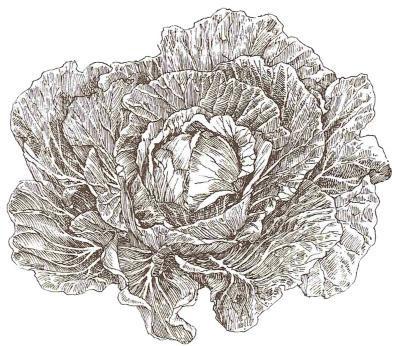
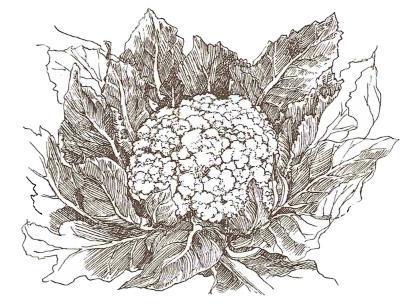
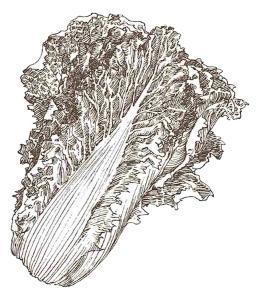
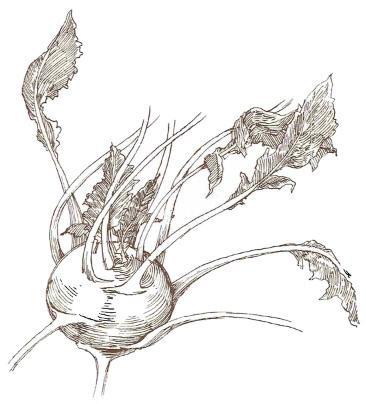
 Victory Seed Company has all the seeds you want for your best garden in 2024.
Victory Seed Company has all the seeds you want for your best garden in 2024.
For 25 years, the family-owned Victory Seed Company has provided the highest quality vegetable, herb and flower seeds to families across the country. We are passionate about providing you the best seeds available that give excellent germination, robust plants, and the harvest you want. With a catalog of over a thousand varieties, we have everything, and our prices are the kinds that we'd want to pay. We have hundreds of yesterday's heirloom vegetables, as well as today's award winning hybrid selections. Get to know us by visiting our website and browsing through our online vegetable seed catalog.
| 1. The Cole Crop Family ← you're on this article right now |
| 2. Broccoli Essentials |
| 3. Cabbage Essentials |
| 4. Cole Crops and Soil |
| 5. Planning for Cole Crops |
| 6. Fall Cole Crop Bonus |
| 7. Hardening-Off Your Cole Crops |
| 8. Starting Cole Crop Seeds Indoors |
| 9. Brussels Sprout Essentials |
| 1. The Cole Crop Family ← you're on this article right now |
| 2. Broccoli Essentials |
| 3. Cabbage Essentials |
| 4. Cole Crops and Soil |
| 5. Planning for Cole Crops |
| 6. Fall Cole Crop Bonus |
| 7. Hardening-Off Your Cole Crops |
| 8. Starting Cole Crop Seeds Indoors |
| 9. Brussels Sprout Essentials |